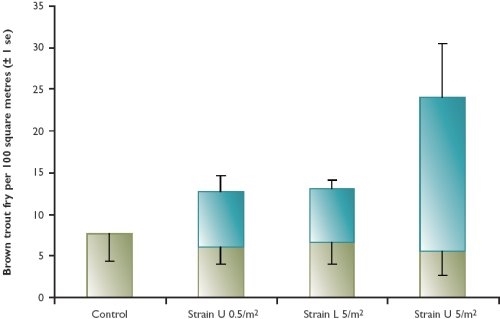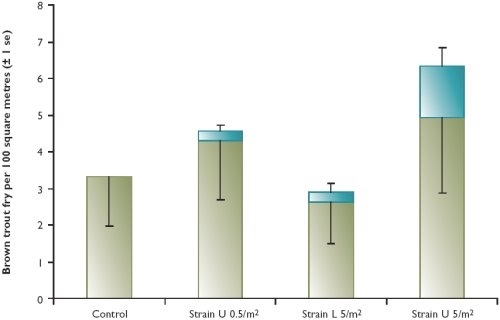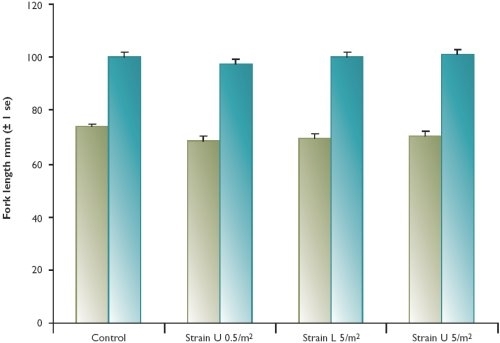Key findings
- The upland strain of fry showed higher fidelity to the release site than the lowland strain in both upland and lowland sites.
- Stocking with fry did not affect numbers of wild fry.
- In upland rivers fry stocking caused a small reduction in growth rates of wild fry.
- Stocked fry grew better at lower stocking densities.
- Fry stocking was more successful in upland than lowland rivers.
We used two water courses representative of upland rain-fed rivers (River Arrow and River Honddu) and three lowland spring-fed chalk streams (River Wylye, River Piddle and River Allen). In each river category, we randomly allocated 24 sites (each 50 metres long and at least 100 metres away from any other site) with one of three stocking treatments and a control, using two strains of farmed fry − one reared in a farm with an upland river source (strain U) and one reared in a farm with a lowland chalk spring source (strain L).
The three treatments used were strain U fry stocked at a density of 0.5 per square metre, strain U fry stocked at a density of five per square metre and strain L fry stocked at a density of five per square metre. Both strains were mixed-sex diploids and were derived from wild fish over 15 years ago. Strain L fry were nearly three times heavier and about 30% longer than strain U fry at the time ofstocking. All fry were marked using fluorescent calcein before stocking.
We electro-fished the sites for a baseline survey in summer 2003. We introduced the farmed fry in spring 2004, and followed this with a post-treatment survey in summer 2004. We counted and measured all brown trout fry and identified them as either wild (no calcein mark) or farmed (calcein-marked).
The recapture rate of farmed fry depended partly on the strain (see Figure 1), with strain U consistently exhibiting the highest site fidelity. The upland rivers were also the most successful in holding farmed fry. This was probably due to the prevalence of boulders and cobbles which provide nursery habitat for juvenile brown trout. Figure 1 illustrates the relative success of both river types in holding farmed fry.
Figure 1: The mean contribution of farmed brown trout fry to the total fry population in upland rivers (top) and lowland chalk streams (bottom), by treatment


Error bars pointing downwards refer to wild fry; those pointing upwards refer to stocked fry. There were no stocked fry in the controls.
We found that farmed fry had no significant effect on the numbers of wild fry in either upland or lowland sites. However, the wild fry were slightly (but significantly) bigger in unstocked control sites than in stocked treatment sites in upland rivers (see Figure 2). Although the differences were small, this suggests that fry stocking reduces the growth rate of resident wild fry which might have implications for their future survival. Among the treatment sites, the smallest wild fry were in strain U (5/m2) sites, probably due to the higher densities of farmed fry recovered at these sites (see Figure 1).
Generally, the densities of farmed fry recaptured in 2004 were proportional to the wild fry baseline density in 2003. In other words, fewer farmed fry were recovered in those areas where wild fry numbers were originally low. This suggests that fry stocking programmes used to mitigate for wild fry absence or decline may be ineffective.
In lowland chalk streams, recaptured fry of all types, wild, strain U and strain L, were significantly bigger than their upland counterparts. This supports the idea that fry grow better in chalk streams than in upland rivers.
The average size at recapture of strain U in upland sites was significantly higher in the low (0.5/m2) stocking sites than the high (5/m2) indicating that they grow better when stocked in lower numbers.
This study demonstrates that the success of farmed fry stocking programmes, in terms of numbers recaptured, depends on the nature of the receiving river, with fry stocking in upland rivers proving much more successful than in chalk streams. Stocking at high densities (5/m2) can considerably increase total fry abundance in upland rivers without affecting the underlying numbers of wild fry, although it does reduce their growth. However, stocking farmed fry at the lower density (0.5/m2) improved their survival rate as well as growth.
Figure 2: The size (mean fork length, mm) of upland river and lowland chalk stream wild brown trout fry sampled during the summer/autumn period after stocking, by treatment
